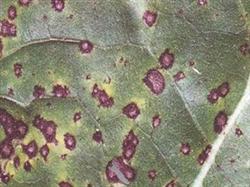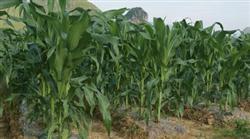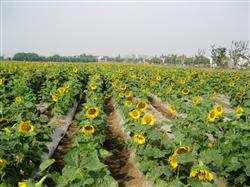Control of sunflower brown spot

Sunflower brown spot, also known as spot blight, occurs widely in China, which can cause seedling death in the early stage and premature leaf death in the later stage, which has a great impact on yield. At the initial stage of the disease, nearly round disease spots were formed on the cotyledons or young leaves, with a diameter of 2-6 mm. The lesion is brown on the front, surrounded by a yellow halo, and grayish white on the back. In the adult stage, the disease forms irregular or polygonal brown spots on the leaves, sometimes surrounded by yellow halo rings, gray in the center of the disease spots and scattered black spots, that is, the conidia of pathogens. In severe cases, there are a series of disease spots, which withered the leaves. Petioles and stems can also be diseased, with brown narrow spots. Another kind of leaf spot disease often occurs on sunflowers, called black spot. When diagnosing, it should be noted that the spot of black spot is relatively large, with concentric wheel lines, and brown mildew occurs on the spot when the weather is wet. Sunflower brown spot disease overwinters with conidia on the diseased remains, that is, those small black spots or hyphae. When appropriate temperature and humidity are encountered in spring and summer, especially continuous rainfall, the pathogen can distribute a large number of conidia and spread by wind and rain. Generally in the continuous cropping land, low-lying land, the land where the disease was more serious in the previous year, the disease was more serious when it was rainy and the field humidity was high. The following points should be paid attention to in the control of sunflower brown spot: crop rotation, rotation with Gramineae crops for more than 3 years; thorough removal of diseased and residual leaves before cultivation, deep turning of soil, reduction of bacterial source; selection of disease-resistant varieties according to local conditions Strengthen field management, including reasonable close planting, use of fully mature organic fertilizer, balanced fertilization, suitable sowing, reasonable irrigation, etc., timely elimination of stagnant water in the field after rain, reduction of field humidity, and manual removal of diseased leaves and bottom leaves in the early stage of the disease. For chemical control, the pathogen of sunflower brown spot is a relatively common fungus, and many fungicides are effective against it, such as 50% carbendazim wettable powder 500 times or 70% thiophanate methyl wettable powder 1000 times, or 30% basic copper sulfate (Lvdebao) suspension 400 times 500 times, 50% carbendazim 1500 times. It is generally necessary to prevent and cure it once or twice at an interval of 10 days.
- Prev

Four determination of fertilization for High yield of Spring Maize
In recent years, due to the lack of organic fertilizer input and people's demand for increasing per unit yield, the amount of fertilizer applied to corn has increased significantly, and the application area of some high concentration compound fertilizers has also been expanded, which has effectively promoted the increase of yield. but there are often fertilizer damage at seedling stage, element deficiency or late fertilizer loss and yield reduction, farmers.
- Next

High-yield cultivation of Sunflower
The environment requires that sunflowers have strong low temperature tolerance in both seedling stage and mature stage. The seeds began to swell and germinate at 2 ℃-4 ℃, germinated at 4 ℃, could emerge at 5 ℃, and could meet the needs of normal emergence at 8 ℃-10 ℃. The seedlings can withstand a low temperature of several hours to 4 ℃, and can still recover after low temperature.
Related
- The first cup of black tea in spring, the flavor and history of tea gardens in Kenya, Africa
- The computer can not only choose potatoes, but also grow tea rice. AI will grow winter oolong tea champion.
- It is not only the inflated tea bitten by insects, but also engraved with the four seasons tea in Beipu.
- The Oriental Beauty Tea Festival in Zhuxian County takes the stage at the weekend to experience the plus-size feast of oil tea.
- & quot; Oriental Beauty Tea & Exploration of Emei in Hsinchu, the hometown of quot;
- The new variety of strawberry "Tainong 1" dessert is the first choice with mellow aroma. Crimson gorgeous
- History of Tea in Taiwan: from Wild Inner Mountain to Export Tea Garden
- Two types of Taiwan Oriental Beauty Black Tea won the British three-Star Award for Childhood Tea Xiang Zhang Jiaqi changed from pilot to champion tea maker.
- Banana species and varieties: the planting history of Taiwan Xianren banana and dwarf banana is long, is banana disease resistant?
- Coffee planting Technology: Qianjie Coffee from Seedling to harvesting

